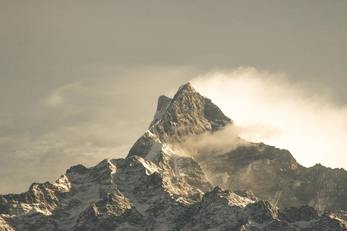|
There is no place to seek the mind; It is like the footprints of the birds in the sky. --- Zenrin Every contemplative tradition has what might be called "objectless" meditation emphasizing the characteristics of awareness. As simple as it may seem, it can be challenging for most, so here's an incremental practice to create the qualities of stability, reflectivity and resilient equanimity needed for such "objectless" meditation. Most meditation practices offer quite specific instructions as to what object to focus on such as the breath, a mantra, a candle flame or geometric image such as a yantra as well as what to do regarding the chosen object of meditation. The Buddha himself offered over 40 objects of meditation, including the breath, various aspects of the physical body, sensations, mental experience, including emotion and thoughts, as well as “objects of mind,” where the yogi is instructed to analyze lived experience into categories that constitute core aspects of the Buddha’s teaching such as the Five Hindrances (craving, aversion, dullness, restlessness, and confusion), or the Seven Factors of Awakening (mindfulness, inquiry, energy, joy, ease, concentration, and equanimity). These classifications are not in themselves the objects of meditation, but are points of reference to be applied during practice to whatever experiences arise. But in the last analysis, the meditative state lies beyond any such practices. Meditation is ultimately not something we do, but rather a state that arises when all doing is done with! As I once heard Swami Satchidananda say, “meditation is an accident, and yoga practices make us accident prone.” But all traditions also speak of “methodless methods” that are meant to drop us directly into that meditative state variously called “silent illumination,” “just sitting,” “mahamudra,” or simply “choiceless awareness.” Such “practices” encourage sitting as awareness itself, not picking or choosing what to focus on, but maintaining an evenness of attention on whatever arises in the space of awareness. Tilopa, in his “Song of Mahamudra” writes: The clouds that wander through the sky Have no roots, no home; nor do the distinctive Thoughts floating through the mind. Once this is seen, Discrimination stops… Rest at ease your body. Giving not, nor taking, Put your mind at rest. Mahamudra is like a mind that clings to nothing. Thus practicing, in time you will reach Buddhahood. Students of Patanjali’s Yoga Sutra might be reminded of what he has to say about asana: “It is a posture that is stable and easeful, accompanied by the relaxation of effort and the arising of coalescence, revealing the body and the infinite universe as indivisible. Then one is no longer disturbed by the play of opposites.” (The Yoga-Sutra of Patanjali, II: 46 – 48). But this is easier said than done. Not for nothing is the mind likened to a drunken monkey! It is all too easy to become caught in an ever-proliferating chain of thought. Even when trying to focus on one object, such as your breath or a mantra, a thought can arise, which leads to another, and another, and yet still more thoughts until fifteen minutes later, when the meditation period is over, we wake up from some four-star daydream or sexual fantasy or a fretful worrying over our unpaid bills! There is a distinct, but subtle difference between being aware of a thought and thinking a thought, and it’s primarily one of “feeling-tone” which is a term referring to the felt sense (physically and energetically) of experience. A thought you are aware of with bare attention – with neither grasping nor aversion – feels light; there is a felt sense of distance between the thought and the awareness of the thought. With no reactivity to feed it, it arises like a bubble, awareness merely reflecting it, without it giving rise to another thought, it eventually “pops” or “self liberates.” Conscious thinking feels much heavier and substantial. It has a compulsive quality that pulls you in and takes control of consciousness. Its very nature is obsessive, leading you into ever deepening entanglement with its story making. Choiceless awareness requires a mode or perception that is all accepting, non-reactive, neither clinging nor resisting. It expresses our willingness to be with our lived experience as it actually is, and not as we would like it to be. There is no seeking after another state of being; no distracting ourselves from whatever is our present situation. In order to cultivate such a mode of perception, it is best not to expect anything, avoid straining and rushing, accept everything that arises and hold onto nothing, avoiding rumination and comparing, and above all, be gentle! Choiceless awareness rests on our ability to concentrate and reflect. This relates to Patanjali’s imperative to be stable and relaxed. The following meditation is in three parts that can each be practiced as independent ‘stand-alone’ practices or combined in a graduated path towards choiceless awareness. Mountain Meditation cultivates stability and is particularly helpful in dealing with anxiety, restlessness and dullness. Lake Meditation cultivates the quality of reflectivity that lessens the reactivity of comparing and judging mind. And finally Big Sky Mind opens us to the freedom of choiceless awareness. Mountain Meditation  Create a comfortable, stable, supported seated posture. If sitting on the floor, make sure you have enough height under your buttocks so that your knees rest on the floor. If that is not possible, then bring the floor up to your knees with pillows or blocks so that your legs are fully supported. Sit upright, and close your eyes. Let your breath flow naturally, making no attempt to manipulate it, rest your attention on the rising and falling of your belly or chest (wherever you most feel the movement of your breath). Next, visualize or imagine a majestically tall mountain. Contemplate for a few minutes how solid and stable the mountain seems, throughout all the changing seasons and in all kinds of weather. At times the mountain may be clouded over, its peak completely in fog, sometimes the mountain is assaulted with thunder, lightening, heavy rains. Sometimes it rises into a clear blue sky, or a sky with just a few white puffy clouds. At times it is covered in snow, at times with lush foliage, and at other times it is barren. And yet, throughout it all, there is a sense of stability, and solidity that remains, not affected by the changing weather or seasons. It is this stable quality that nourishes our concentration and ability to sit through all the varying experiences that arise while practicing. So, now draw the image of the mountain down into your body and feel your posture of meditation to be like a mountain. Breathing in, see yourself as a mountain; breathing out, feeling stable. Some thoughts and emotions are like thunderous storms, others like a sunny day, your mind can be clouded over or clear and bright, but through it all, you can still sit solid like a mountain. Lake Meditation  Towards the peak of some mountains in the Himalayas, there are crystal-clear, turquoise hued lakes called “sky lakes” because they are so reflective they reflect perfectly the sky above. Protected by the higher peaks and trees, the surface of such a lake is smooth and calm. The water is as reflective as a mirror, so you can see your face and the sky above reflected in its surface. What you notice about the reflection is that the water reflects only what is there, neither editing out nor adding in anything. It reflects the dark, ominous storm clouds as well as the fluffy white clouds equally. When birds fly overhead, it reflects them without a trace left on the surface once they are gone from the sky. Mind, or citta, when the waves or vritt are calmed, has this quality of the lake to be reflective. Once stabilized, we can turn our attention to this reflective quality of the mind. Thoughts, feelings and emotions may arise from the depths of our mind, and we can simply reflect what arises without adding anything extra by way of judging, or comparing, nor editing out anything through aversion or denial. Perceptions of sound, smell or touch may arise, and free of grasping and pushing away, we can simply reflect. In this way, destructive or unwholesome patterns can be seen so that their power over us is lessened. Attachments are loosened. Breathing in, see yourself as the water of the Sky Lake; breathing out, reflecting. Big Sky Mind  After awhile, it occurs to you to turn your attention from the reflections upon the surface of the lake, towards the sky itself. This is what the Korean Zen teacher Chinul called “tracing the radiance.” You note that the sky is boundless, limitless. It contains everything that arises without stain. Even the horizon is only an apparent perceptual/conceptual boundary that can never be reached. Even on the cloudiest day, you know that above the clouds the sky is luminous, all pervading, limitless and free. Awareness itself is said to share these qualities of limitlessness, luminosity and stainlessness. Awareness is present always but generally overlooked as we tend to focus on the thoughts, perceptions, and emotions. If you have ever told yourself something like “I’m confused,” then obviously awareness was also present or how would you have known?! What Big Sky Meditation opens us to is the realization that this awareness is also there and it creates a sense of space to hold all that arises with greater equanimity.
Now, Patanjali made a "thing" out of awareness, and calling it purusha, says that this is what you "really" are: pure awareness. And this is where we have to be careful with the analogy to the sky. The Buddha taught that there is no 'self' that exists behind, beyond, or above the ever-changing phenomena. It would be more accurate to speak of 'aware-ing' as a process that arises in mutual dependence upon what it is that is perceived. For instance, again using the example of confusion: when someone says "I'm confused" Patanjali's dualism would posit that the mistake is identifying with the confusion and not with the awareness of the confusion. Indeed, it may phenomenologically feel like they are two completely separate things, but the awareness arises with the confusion. When this is understood, the selfless nature of phenomena is seen vividly. We break through into the realization of what the Buddha called “not-self.” With the realization of not-self, the conceit of “I,” is eliminated and the freedom of liberation manifests.
6 Comments
11/5/2018 04:22:32 pm
I am so glad to receive your e-mails....so happy that you are doing them. Thank you. Thank you. Thank you.
Reply
11/5/2018 04:59:06 pm
Thank YOU, Susan! I hope you find that future mailings are also helpful. If there's anything you'd particularly be interested in, please let me know!
Reply
Jolene Hutton
6/30/2019 04:55:58 pm
Thank you for this. I just received my first newsletter and it had this link included. I appreciate the timing of these meditations and send love and light to you for Sharing these gifts of meditation. Thank you. I will also send you healing light for your health - my thoughts are with you!
Reply
Frank Jude Boccio
6/30/2019 05:08:50 pm
Thank you, Jolene! And I hope you enjoy the guided meditation audio included in the newsletter. You can stream it and/or download it as it's my free offering to all who subscribe to my newsletter!
Reply
8/13/2022 01:44:25 am
I bet someone who does yoga ended up producing this particular quote - it is an absolutely beautiful quote all in all. Yoga opens your mind; there are no two ways around that!
Reply
Sandy Masters
6/2/2024 09:02:05 am
Thank you for sharing. Do you post emails ?
Reply
Leave a Reply. |
AuthorPoepsa Frank Jude Boccio is a yoga teacher and zen buddhist dharma teacher living in Tucson, AZ. Categories |

 RSS Feed
RSS Feed